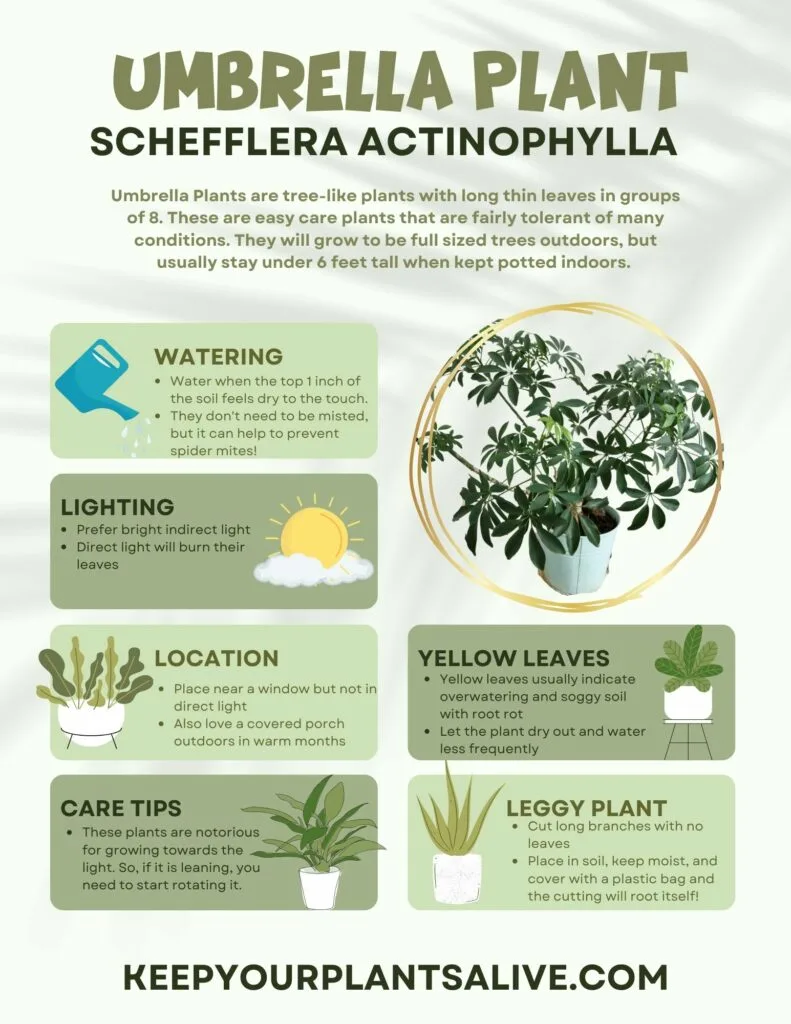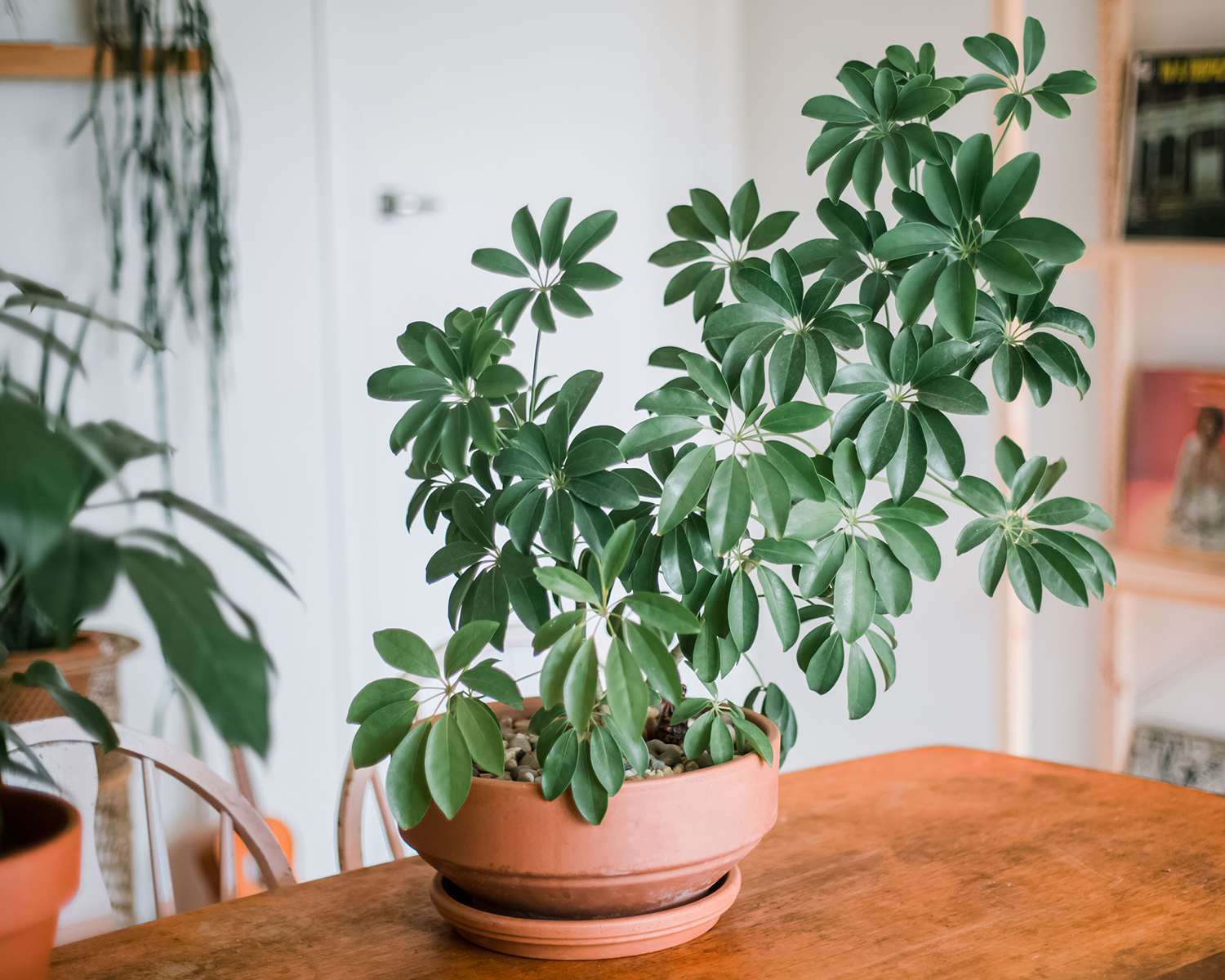Umbrella plants are easy to grow indoor plants that provide a refreshing green touch to any room. They are low-maintenance and can thrive in a variety of light conditions, making them an ideal choice for beginners and plant enthusiasts alike. In this guide, we’ll cover everything you need to know about growing and maintaining umbrella plants, from soil requirements to watering schedules, so you can enjoy the beauty of these lush plants all year round.
Whether you’re looking to add some greenery to your home or office, or simply want to expand your plant collection, the umbrella plant is a great option. With its striking foliage and easy care requirements, it’s no wonder this plant is a favorite among plant lovers. In this guide, we’ll take a closer look at how to grow and maintain umbrella plants, so you can enjoy their beauty and health benefits for years to come.

Guide to Growing and Maintaining Umbrella Plants
Umbrella plants are a popular indoor plant known for their large, umbrella-shaped leaves. These plants are easy to grow and maintain, making them a great choice for both novice and experienced gardeners. In this guide, we will provide you with all the information you need to successfully grow and maintain your own umbrella plant.
Choosing the Right Location
Umbrella plants thrive in bright, indirect light. Avoid placing them in direct sunlight as this can scorch the leaves. They can also tolerate low light conditions, but this may cause the plant to grow slower. Make sure to keep your umbrella plant away from cold drafts, such as near windows or doors in the winter.
When choosing a location for your umbrella plant, consider the size of the pot. These plants can grow up to 6 feet tall, so make sure to choose a location with enough space to accommodate their size.
Benefits of Umbrella Plants
– Air purification: Umbrella plants are great at removing toxins from the air, making them a popular choice for indoor spaces.
– Low maintenance: These plants are easy to care for and can tolerate a variety of lighting conditions.
– Aesthetic appeal: The large, umbrella-shaped leaves make for a unique and attractive addition to any indoor space.
Watering and Feeding
Umbrella plants prefer moist soil, but overwatering can lead to root rot. Water your plant when the top inch of soil is dry to the touch, and make sure to drain any excess water from the saucer beneath the pot.
Feed your umbrella plant once a month during the growing season with a balanced, water-soluble fertilizer. Do not fertilize during the winter months when the plant is dormant.
Umbrella Plant vs. Other Indoor Plants
Compared to other indoor plants, umbrella plants require less maintenance and can tolerate a wider range of lighting conditions. They also have a unique and attractive appearance that makes them a popular choice for indoor spaces.
Pruning and Propagation
To keep your umbrella plant looking its best, prune away any dead or yellowing leaves as they appear. You can also shape the plant by cutting back any branches that are growing too long.
Umbrella plants can be propagated through stem cuttings. Take a cutting from a healthy, mature plant and place it in a pot with moist soil. Keep the soil moist and the cutting should root within a few weeks.
Umbrella Plant Care Tips
– Keep your plant away from cold drafts and direct sunlight.
– Water your plant when the top inch of soil is dry to the touch.
– Feed your plant once a month during the growing season.
– Prune away any dead or yellowing leaves as they appear.
– Propagate your plant through stem cuttings.
Pests and Diseases
Umbrella plants are relatively pest-free, but they can be susceptible to mealybugs and spider mites. Keep an eye out for any signs of infestation, such as white webs or cotton-like growths on the leaves.
If you notice any pests, remove them with a cotton swab dipped in rubbing alcohol. You can also spray the plant with a solution of water and neem oil to prevent future infestations.
Umbrella Plant vs. Artificial Plants
While artificial plants may require less maintenance, they do not offer the same air-purifying benefits as live plants. Umbrella plants are also more aesthetically pleasing and can add a natural element to any indoor space.
Conclusion
Umbrella plants are a great choice for indoor gardening due to their low maintenance requirements and unique appearance. By following the tips outlined in this guide, you can successfully grow and maintain your own umbrella plant. Remember to choose a bright, indirect location, water and feed your plant appropriately, prune as needed, and keep an eye out for any pests or diseases.
Frequently Asked Questions
Here are some common questions and answers about growing and maintaining umbrella plants.
What is an umbrella plant?
An umbrella plant, also known as Schefflera, is a tropical houseplant with large, glossy leaves that resemble an umbrella. It is a relatively easy plant to care for and can grow up to 6 feet tall indoors.
To keep your umbrella plant healthy, make sure to provide it with ample light, water, and nutrients. You can also prune it regularly to maintain its shape and size.
How much light does an umbrella plant need?
Umbrella plants thrive in bright but indirect light. Direct sunlight can scorch their leaves, so it’s best to keep them near a window that receives filtered or partial sunlight. If you notice your plant’s leaves turning yellow or brown, it may be getting too much or too little light.
If your umbrella plant is not getting enough light, you can supplement it with artificial light using a grow light. Keep the light on for 12-16 hours per day to provide your plant with the necessary light it needs to grow and thrive.
How often should I water my umbrella plant?
Umbrella plants prefer moist but well-draining soil. Water them once a week or when the top inch of soil feels dry to the touch. Avoid over-watering your plant, as this can lead to root rot and other issues.
If you notice your plant’s leaves turning yellow or dropping, it may be a sign of over-watering. On the other hand, if the leaves are wilting or drooping, it may be a sign of under-watering. Adjust your watering schedule accordingly to keep your plant healthy and happy.
How do I prune my umbrella plant?
Pruning your umbrella plant can help maintain its shape and size, as well as promote new growth. Use clean, sharp pruning shears to make cuts just above a leaf node. This will encourage new growth and prevent your plant from becoming too leggy.
You can also remove any yellow or brown leaves to keep your plant looking its best. Avoid pruning your umbrella plant too heavily, as this can stress the plant and make it more susceptible to disease and pests.
What pests and diseases should I watch out for with my umbrella plant?
Umbrella plants are relatively pest-resistant, but they can still be susceptible to mealybugs, spider mites, and scale insects. Check your plant regularly for any signs of infestation, such as white or black spots on the leaves, sticky residue, or yellowing leaves.
If you notice any pests, you can remove them by wiping the affected leaves with a damp cloth or using an insecticidal soap. Avoid over-fertilizing your plant, as this can attract pests and make your plant more vulnerable to disease.

Umbrella Plant Care | Schefflera Care | Tips N Tricks | Indoor Gardening | Bubbles of Green
In conclusion, growing and maintaining umbrella plants can be a fun and rewarding experience for both novice and experienced gardeners. By providing adequate light, water, and nutrients, these plants can thrive and add a touch of greenery to any indoor or outdoor space.
Remember to regularly inspect your plants for pests and diseases, and promptly address any issues that arise. With a little bit of care and attention, your umbrella plant can live a long and healthy life.
So why not give it a try? Whether you’re looking to add some greenery to your home or office, or simply enjoy the process of growing and nurturing plants, the umbrella plant is a great choice. So grab your gardening gloves and get started today!
